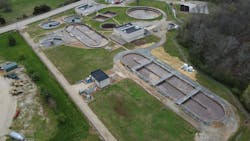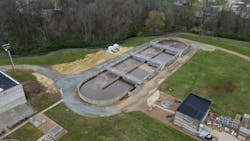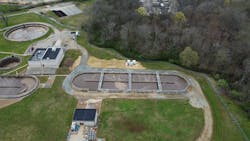City of Farmington Missouri NE WWTP | 2023 WWD Top Projects
- Location: Farmington, Missouri
- Cost: $500,000
- Size: 1,400 GPM
- Owner: Larry Lacy, City of Farmington
- Designer: Brian Gentges, Cochran
- Contractor: Bill Giessing, Brockmiller Construction
- Manufacturers: Jaeger Aeration
Nutrient limits for total phosphorus and total nitrogen for the Farmington, Missouri Northeast Wastewater Treatment plant drove the need for a $500,000 retrofit project.
Larry Lacy, Farmington public works director, said the surface aerators and mixers had reached the end of their useful lives. In particular, the aspirating aerators had been in use for five to nine years and were beginning to show mechanical failure, resulting in increased energy costs. Most notably was that those mechanical failures were creating difficulties for the plant to meet the TP and TN requirements of the National Pollutant Discharge Elimination System (NPDES) permit as the city’s population began to grow. That aging equipment was only one element the project aimed to address, Lacy noted.
“The existing system was very challenging to maintain because staff had to perform much of the maintenance from a johnboat,” Lacy said. “The existing system was very energy inefficient. There were times that the plant did not meet nutrient reduction limits in the NPDES permit.”
Lacy attended a seminar about ways to reduce operations and maintenance costs while improving TP and TN removal to meet discharge limits without selector basins. During that seminar he learned about the OxyStrip system, which is able to meet less than 5 ppm of TN and less than 1.4 ppm of TP. It does this by pumping air through the membrane rather than using a prop for mixing and an air pump to entrain air.
“We were able to remove 12 pieces of equipment and replaced them with four,” he said.
Despite that reduction in pieces of equipment, Lacy said it introduced redundancy into the oxidation ditch, which it previously did not have, while also leading to reductions in operations and maintenance costs.
The system aerates the water so quickly that operators can turn off the blowers and create an anoxic condition to more effectively remove nutrients, he added.
“Thus, we also solved our future NPDES permit issues on TN and TP with this system since now we easily meet any future permit requirements without another construction project, saving millions of dollars,” Lacy said.
The project was constructed during February, which Farmington workers had identified as a low-flow period of the year, so as to avoid the challenges of construction during higher flow seasons. Lacy said construction took less than a week, and noted the fortune of a mild weather kept the project on time and on budget.
That being said, draining the basins presented the biggest hurdle in construction. While the initial draining removed a great deal of water and sediment it was not enough for construction to proceed. Construction staff built cofferdams to get the remaining water out of the basins, which still had 4 to 6 inches of water during the 2.5-day construction period. One final disruption was a faulty communication wire, which an electric controls company corrected after also finding an interference issue with a variable frequency drive.
“Overall construction was less than one week of time outside of pre-installation work,” Lacy said.
The plant is running as intended since construction finished Feb. 9, 2023. Energy savings estimates indicate an expected savings of approximately $80,000, or the equivalent of 65 homes’ electricity usage.
Watch the Farmington WWTP Top Projects video:
About the Author
Bob Crossen
Bob Crossen is the editorial director for the Endeavor Business Media Water Group, which publishes WaterWorld, Wastewater Digest and Stormwater Solutions. Crossen graduated from Illinois State University in Dec. 2011 with a Bachelor of Arts in German and a Bachelor of Arts in Journalism. He worked for Campbell Publications, a weekly newspaper company in rural Illinois outside St. Louis for four years as a reporter and regional editor.



